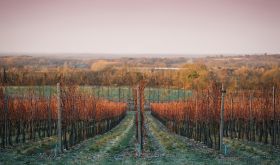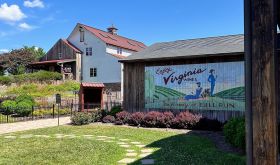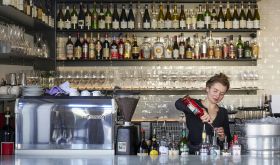For a long time Bordeaux did not like change. The city was very aristocratic, surrounded by secrets, and dominated by the image of wine. Les Chartrons along the docks is a beautiful line of bourgeois architecture totally dedicated, in the 18th century, to the wine trade. Today, wine merchants no longer represent the majority of Bordeaux's commercial activity and the rehabilitation of this district is devoted to urban projects. Bordeaux must evolve to reinvent itself. The entire city, with the go-ahead mayor Alain Juppé, is in movement. The docks are being rehabilitated, downtown is festive and has a vibrant spirit, and wine is now celebrated through the very popular Fête du Vin (from 26 to 29 June this year).
This new wave gives Bordeaux a new face, with the help of people from other regions or countries. This melting pot adds some creativity and modernism to the city, especially to its restaurants. From 1980 to 2000, Bordeaux was not the best place to taste beautiful wine. But today, with the new generation of young professionals and some students, wine is enjoying a new dynamism. A lot of wine bars have been opened and downtown Bordeaux is now a great place to taste affordable bordeaux or even, more amazingly, wines from Beaujolais, Burgundy and other regions. 
L’Univerre is one of the archetypes of this new restaurant. Set in the centre near the contemporary courthouse, Univerre is a new version of the French bistrot/wine bar. The landlord Fabrice Moisans is passionate about wine and also formerly owned another punning winebar Verretigo. Here, the food is rather simple but prepared with good products and an international vision: mozzarella and mesclun salad, roast beef and French fries, veal curry, moussaka. Sweets are light and very good, like the Crémeux du Pays Nantais, a fresh white cheese speciality of Nantes.
But the most incredible part of this restaurant is the cellar. With a huge list of wines from all around the world, you can find some pépites (jewels) from Burgundy and the Rhône Valley (Fabrice Moisans’ favourite regions) that are virtually impossible to find today. There is, for example, an extraordinary line-up from Jean-Louis Chave with 10 vintages of Cuvée Cathelin, affordable wines from Domaine Rousseau in Gevrey, and Dauvissat Chablis by the glass for only €8. And of course there's a beautiful list of Bordeaux wines. The ambiance is casual, welcoming and I like the Zalto glasses, well balanced and perfect to taste wine with meals. Altogether, it is the ideal place for wine enthusiasts.

Outside the town, in Lormont just up from the Pont d’Aquitaine, a familiar landmark, is the Restaurant Le Prince Noir from which Jean-Marie Amat, Bordeaux’s iconic chef, retired this spring. After 40 years of hard work, this modernist iconoclast and revolutionary chef has left his restaurant to younger generations. Amat has revolutionised the food and the hotel philosophy in Bordeaux. With the Saint-James restaurant, he made a creative cuisine with spices, oil, fresh products and a touch of sensitivity. This sensitivity was honoured by Alain Ducasse, who inaugurated this 'new' restaurant and launched the new guide of Châteaux et Hôtels Collection, the luxury collection of charming hotel and gourmet restaurants, last month. He observed at the launch that 'cuisine is not a matter of nationality but of sensitivity.' The new Chef of Prince Noir, Vivien Durand, perfectly illustrates this.
Born in the south-west of France, Vivien started to work with Thierry Thiercelin in St-Tropez before working with Ducasse in the Louis XV in Monaco. In 2003, he decided to work with Nicolas Masse, the chef of the Grand Hôtel in St-Jean-de-Luz in Basque country. After getting some experience, he went on to Hendaye (also in Basque country) with Pierre Eguiazabal from Cave Eguiazabal. There the two men developed the concept of tapas and pintxos, these typical light dishes from Spain in a wine bar. The first year, Vivien became the first non-Spaniard to win the 'World Cup of Pintxos' in San Sebastian. And in 2012 he was recognised as one of the 'young talents' by the Guide Michelin with one star. Again, it was the first time in the world that a wine bar had won this prize.
When Jean-Marie Amat decided to retire, he spoke to his best friend Alain Ducasse, who then started to search for a successor. Both Michel Guérard of Les Prés d’Eugénie and Martin Berasatégui from San Sebastian recommended Vivien. 'After two days of reflection I accepted', said Vivien. The meeting with Jean-Marie Amat was the first step. These two chefs did not know each and they soon got along. As Alain Ducasse said, food is sensitivity…
Vivien Durand is passionate about good products and fresh harmony. The dishes are actually simple but not less original, and increasingly connected to the terroir of Bordeaux and Aquitaine. Fish comes from St-Jean-de-Luz, the pigeon from a rural farmer, and vegetables from local market gardeners. Vivien likes the pintxos philosophy and proposes five or six further courses with dynamic, fresh energy and beautiful balance. I particularly fell in love with a local fish (mulet?) with meunière sauce and Médocain chanterelles (pictured top left), a delicious octopus from Getaria in Spain, and a perfectly cooked pigeon with avocado à la plancha. The wine list is not totally in harmony with the food served but with time, Vivien will surely balance food and wine better. Le Prince Noir in Lormont is for me the best restaurant in Bordeaux and surely the upcoming Michelin two-star in Bordeaux. 














